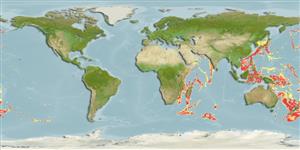>
Ophidiiformes (Cusk eels) >
Ophidiidae (Cusk-eels) > Neobythitinae
Etymology: Mastigopterus: Greek, mastax, -agos = bite + Greek, pteron = wing, fin (Ref. 45335).
More on authors: Smith & Radcliffe.
Environment: milieu / climate zone / depth range / distribution range
Ecologia
marino batidemersale; distribuzione batimetrica 394 - 2365 m (Ref. 43943). Deep-water
Indo-West Pacific: Madagascar, the East and South China seas and Papua New Guinea.
Size / Peso / Age
Maturity: Lm ? range ? - ? cm
Max length : 53.5 cm SL maschio/sesso non determinato; (Ref. 43943)
Head large; mouth subterminal. Eye diameter less than snout length. Opercular spine weak, broad, and flattened. Prominent cephalic sensory pores below eyes and on rear margin of preoperculum. Median basibranchial tooth patches 2. Vomer with V-shaped tooth patch. Anterior gill arch with 10-12 long rakers. Pectoral fins 12-15 rays, the longest about 1/2 or more in SL. Pelvic fins with 2 joined rays in each. Caudal fin rays 6. Branchiostegal rays 8. Precaudal vertebrae 15-16. Cycloid scales small, deciduous, covering head, body, and bases of dorsal, anal, and pectoral fins. Lateral line indistinct (Ref. 43943).
A rare species inhabiting the deep-sea floor in the tropical to temperate waters (Ref. 43943). Reproductive strategy possibly similar to other members of this family featuring oviparity, with oval pelagic eggs floating in a gelatinous mass (Ref. 205).
Life cycle and mating behavior
Maturità | Riproduzione | Deposizione | Uova | Fecundity | Larve
Nielsen, J.G., D.M. Cohen, D.F. Markle and C.R. Robins, 1999. Ophidiiform fishes of the world (Order Ophidiiformes). An annotated and illustrated catalogue of pearlfishes, cusk-eels, brotulas and other ophidiiform fishes known to date. FAO Fish. Synop. 125(18):178p. Rome: FAO. (Ref. 34024)
IUCN Red List Status (Ref. 130435)
Threat to humans
Harmless
Human uses
Pesca: di nessun interesse
Informazioni ulteriori
Nomi ComuniSinonimiMetabolismoPredatoriEcotossicologiaRiproduzioneMaturitàDeposizioneSpawning aggregationFecundityUovaEgg development
BibliografiaAcquacolturaProfilo di acquacolturaVarietàGeneticaElectrophoresesEreditarietàMalattieElaborazioneNutrientsMass conversion
CollaboratoriImmaginiStamps, Coins Misc.SuoniCiguateraVelocitàModalità di nuotoArea branchialeOtolithsCervelliVista
Strumenti
Special reports
Download XML
Fonti Internet
Estimates based on models
Preferred temperature (Ref.
123201): 2.6 - 7.8, mean 4.8 °C (based on 786 cells).
Phylogenetic diversity index (Ref.
82804): PD
50 = 1.0000 [Uniqueness, from 0.5 = low to 2.0 = high].
Bayesian length-weight: a=0.00380 (0.00165 - 0.00876), b=3.14 (2.93 - 3.35), in cm total length, based on LWR estimates for this (Sub)family-body shape (Ref.
93245).
Trophic level (Ref.
69278): 3.7 ±0.6 se; based on size and trophs of closest relatives
Resilienza (Ref.
120179): Medio, tempo minimo di raddoppiamento della popolazione 1.4 - 4.4 anni (Preliminary K or Fecundity.).
Fishing Vulnerability (Ref.
59153): Moderate to high vulnerability (46 of 100).
